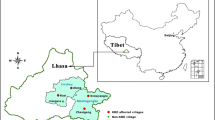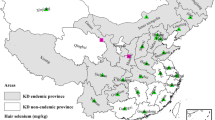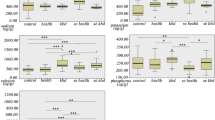Abstract
The causes of Kashin–Beck disease (KBD) in children are multifactorial, and particular consideration has been given to childhood selenium (Se) deficiency. In this study, dietary intake of Se and mercury (Hg) was determined at KBD areas to investigate the Se status and risks. Therefore, total Hg and Se levels were investigated in scalp hair samples and in daily intake food samples of 150 schoolchildren in Yongshou County of Shaanxi, China. The results showed that the average concentration of Se in children’s hair has risen to 302 ng g−1 and significantly increased compared to the data reported decades ago. Children at KBD endemic areas likely have improved Se status due to the Se supplementation in food at recent decades. However, all the children in the study areas still showed lower Se status compared to those in other non-KBD areas of China. The probable daily intake of Se in the study areas was still lower after stopping Se supplementation in food at KBD areas, which is 17.96 μg day−1. Food produced locally cannot satisfy the lowest demand for Se nutrition for local residents. If the interactions of Se–Hg detoxification are considered, Hg intake from food exacerbates Se deficiency at the KBD areas.



Similar content being viewed by others
References
Afridi, H. I., Kazi, T. G., Talpur, F. N., et al. (2015). Assessment of selenium and mercury in biological samples of normal and night blindness children of age groups (3–7) and (8–12) years. Environmental Monitoring and Assessment, 187(3), 1–11.
ATSDR, Agency for Toxic Substances and Disease Registry. (1996). Toxicological profile for selenium (update). Atlanta, GA: Public Health Service, Department of Health and Human Services.
Barbosa, A. C., Jardim, W., Dórea, J. G., et al. (2001). Hair mercury speciation as a function of gender, age, and body mass index in inhabitants of the Negro River Basin, Amazon, Brazil. Archives of Environmental Contamination and Toxicology, 40(3), 439–444.
Brtková, A., Magálová, T., Béderová, A., et al. (1999). Serum selenium levels in healthy slovak children and adolescents. Biological Trace Element Research, 67(1), 49–54.
Chen, Z., Li, H., Yang, L., et al. (2015). Hair selenium levels of school children in Kashin–Beck disease endemic areas in Tibet, China. Biological Trace Element Research, 168(1), 1–8.
Chen, D., Ren, S., & Li, J. (1984). Selenium in soils of Shaanxi province. Acta Pedologica Sinica, 102(2), 588–589.
Chinese National Standard Agency (CNSA). (1994). Tolerance limit of mercury in foods (pp. 171–173). Beijing, China: CNSA. (in Chinese).
Clark, N. A., Teschke, K., Rideout, K., et al. (2007). Trace element levels in adults from the west coast of Canada and associations with age, gender, diet, activities, and levels of other trace elements. Chemosphere, 70, 155–164.
CNS. (1990). Chinese nutrition society recommended daily dietary nutrient supply. Acta Nutrimenta Sinica 12(1), 1–9.
Combs, G. F., Spajjholz, J. E., Levander, O. A., & Oldfield, J. E., eds. (1987). Selenium in biology and medicine. In Proceedings of the third international symposium on selenium in biology and medicine (pp. 859–876). Beijing, New York: Van Nostrand Reinhold Company.
Díez, S., Esbrí, J. M., Tobias, A., et al. (2011). Determinants of exposure to mercury in hair from inhabitants of the largest mercury mine in the world. Chemosphere, 84(5), 571–577.
Díez, S., Montuori, P., Pagano, A., et al. (2008). Hair mercury levels in an urban population from southern Italy: Fish consumption as a determinant of exposure. Environment International, 34(2), 162–167.
Dorea, J. G., & Barbosa, A. C. (2005). Fish consumption and blood mercury: Proven health benefits or probable neurotoxic risk? Regulatory Toxicology and Pharmacology, 42(2), 249–250.
Du, B., Li, P., Feng, X., et al. (2016). Mercury exposure in children of the Wanshan mercury mining area, Guizhou, China. International Journal of Environmental Research and Public Health, 13(11), 1107. doi:10.3390/ijerph13111107.
Fang, T., Aronson, K. J., & Campbell, L. M. (2012). Freshwater fish–consumption relations with total hair mercury and selenium among women in eastern China. Archives of Environmental Contamination and Toxicology, 62(2), 323–332.
FNB, Food and Nutrition Board USA Institute of Medicine. (2000). Dietary references intakes for vitamin C, vitamin E, selenium and carotenoids. Washington: National Academy Press.
Ganther, H. E., Goudie, C., Sunde, M. L., et al. (1972). Selenium: Relation to decreased toxicity of methylmercury added to diets containing tuna. Science, 175, 1122–1124.
Gao, J., Liu, Y., Huang, Y., et al. (2011). Daily selenium intake in a moderate selenium deficiency area of Suzhou, China. Food Chemistry, 126(3), 1088–1093.
Hill, K. E., Zhou, J., McMahan, W. J., et al. (2003). Deletion of selenoprotein P alters distribution of selenium in the mouse. Journal of Biological Chemistry, 278(16), 13640–13646.
JECFA, (Joint FAO/WHO Expert Committee on Food Additives). (2010). Joint FAO/WHO food standards programme, committee of the codex alimentarius commission, 33rd session. Geneva, Switzerland, July 5–9.
Jin, L., Liang, L., Jiang, G., & Xu, Y. (2006). Methylmercury, total mercury and total selenium in four common freshwater fish species from Ya-Er Lake, China. Environmental Geochemistry and Health, 28, 401–407.
Kazi, T. G., Afridi, H. I., Kazi, N., et al. (2008). Copper, chromium, manganese, iron, nickel and zinc levels in biological samples of diabetes mellitus patients. Biological Trace Element and Research, 122(1), 1–18.
Khan, M. A. K., & Wang, F. (2009). Mercury–selenium compounds and their toxicological significance: Toward a molecular understanding of the mercury–selenium antagonism. Environmental Toxicology and Chemistry, 28, 1567–1577.
Kobal, A. B., Horvat, M., Prezelj, M., et al. (2004). The impact of long-term past exposure to elemental mercury on antioxidative capacity and lipid peroxidation in mercury miners. Journal of Trace Elements in Medicine and Biology, 17, 261–274.
Kuklinski, B., Buchner, M., Muller, T., & Schweder, R. (1992). Anti-oxidative therapy of pancreatitis—An 18-month interim evaluation. Zeitschrift fur die Gesamte Innere Medizin und Ihre Grenzgebiete, 47(6), 239–245.
Li, S., Bañuelos, G. S., Wu, L., & Shi, W. (2014). The changing selenium nutritional status of Chinese residents. Nutrients, 6, 103–1114.
Li, J., Ren, S., & Chen, D. (1982). A study of Kashin–Beck disease associated with environmental selenium in Shanxi area. Acta Scientiae Circumstantiae, 2(2), 129–134.
Li, J. M., & Shah, A. M. (2004). Endothelial cell superoxide generation: Regulation and relevance for cardiovascular pathophysiology. American Journal of Physiology-Regulatory Integrative and Comparative Physiology, 287, R1014–R1030.
Lorenzo Alonso, M. J., Bermejo, B. A., Ja, C. D. J., et al. (2005). Selenium levels in related biological samples: Human placenta, maternal and umbilical cord blood, hair and nails. Journal of Trace Elements in Medicine and Biology, 19(1), 49–54.
Mehdi, Y., Hornick, J. L., Istasse, L., & Dufrasne, I. (2013). Selenium in the environment, metabolism and involvement in body functions. Molecules, 18(3), 3292.
Niu, Z., Wang, Y., & Liu, G. (2016). Investigation on hair mercury concentration of people in 8 typical regions of Anhui Province and its influence factors. Environmental Chemistry, 35(3), 533–539.
Ognjanović, B. I., Djordjević, N. Z., Matić, M. M., et al. (2012). Lipid peroxidative damage on cisplatin exposure and alterations in antioxidant defense system in rat kidneys: A possible protective effect of selenium. International Journal of Molecular Sciences, 13(2), 1790–1803.
Pinheiro, M. C. N., Muller, R. C. S., Sarkis, J. E., et al. (2005). Mercury and selenium concentrations in hair samples of women in fertile age from Amazon riverside communities. Science of the Total Environment, 349, 284–288.
Qian, D. (2016). Mercury exposure and relationship between selenium and mercury at low selenium area of Yongshou, Shanxi Province. Master Thesis, China West Normal University.
Rocha, A. V., Almondes, K. G., Almeida, I. S., et al. (2014). Selenium nutritional status of women living in risk area of mercury contamination. Conference: Bioavailability, 39, 1–57.
Sakamoto, M., Yasutake, A., & Kakita, A. (2013). Selenomethionine protects against neuronal degeneration by methylmercury in the developing rat cerebrum. Environmental Science and Technology, 47(6), 2862–2868.
Tan, J. (1990). Chemico-geography of some life elements and endemic diseases with an emphasis on China. Environmental life elements and health (pp. 145–157). Beijing: Science Press.
Taylor, D., Dalton, C., Hall, A., et al. (2009). Recent developments in selenium research. British Journal of Biomedical Science, 66(2), 107–116.
Thomas, V. V., Knight, R., Haswell, S. J., et al. (2013). Maternal hair selenium levels as a possible long-term nutritional indicator of recurrent pregnancy loss. BMC Womens Health, 13(1), 1–6.
Thomson, C. D., McLachlan, S. K., Parnell, W. R., et al. (2007). Serum selenium concentrations and dietary selenium intake of New Zealand children aged 5–14 years. British Journal of Nutrition, 97(02), 357–364.
United States Environmental Protection Agency (USEPA). (1997). Mercury study report to the congress, volume V: Health effects of mercury and mercury compounds. Washington, DC, USA: USEPA.
USEPA. (2007). Method 7473: Mercury in solids and solutions by thermal decomposition, amalgamation, and atomic absorption spectrophotometry. Washington, DC.
Vendeland, S. C., Deagen, J. T., Butler, J. A., & Whanger, P. D. (1994). Uptake of selenite, selenomethionine and selenate by brush border membrane vesicles isolated from rat small intestine. BioMetals, 7, 305–312.
Wang, J., Li, H., Yang, L., et al. (2016). Distribution and translocation of selenium from soil to highland barley in the Tibetan plateau Kashin–Beck disease area. Environmental Geochemistry and Health, 39(1), 1–9.
Whanger, P. D. (2001). Selenium and the brain: A review. Nutritional Neuroscience, 4(2), 81–97.
Xu, S., Zhang, X., Lv, H., et al. (2013). Selenium levels inside and outside environment of Jinlin Province Kashin–Beck disease area. Chinese Journal of Control of Endemic Diseases, 28, 340–342. (in Chinese).
Yang, D. Y., Chen, Y. W., Gunn, J. M., & Belzile, N. (2008). Selenium, mercury in organisms: Interactions and mechanisms. Environmental Review, 16, 71−92.
Yang, J., Tong, W., Wu, C., & Liu, C. (2010). Selenium level surveillance for the year 2007 of Keshan disease in endemic areas and analysis on surveillance results between 2003 and 2007. Biological Trace Element Research, 138(1–3), 53–59.
Zhang, L. (2009). Study on the human hair mercury levels in the residents living in the different function regions in Qingdao and influence factors. Journal of Safety & Environment, 9(4), 95–97.
Zhang, H., Feng, X., Chan, H. M., & Larssen, T. (2014). New insights into traditional health risk assessments of mercury exposure: Implications of selenium. Environmental Science and Technology, 48(2), 1206–1212.
Zhang, H., Feng, X., Zhu, J., et al. (2012). Selenium in soil inhibits mercury uptake and translocation in rice (Oryza sativa L.). Environmental Science and Technology, 46, 10040–10046.
Zhou, J., Feng, X., Liu, H., et al. (2013). Examination of total mercury inputs by precipitation and litterfall in a remote upland forest of Southwestern China. Atmospheric Environment, 81, 364–372.
Zhou, J., Wang, Z., Sun, T., et al. (2016). Mercury in terrestrial forested systems with highly elevated mercury deposition in southwestern China: The risk to insects and potential release from wildfires. Environmental Pollution, 212, 188–196.
Zhu, J. H., Yang, J., & Xin-Ke, H. E. (2010). Investigation on selenium levels of food supplies and people in Keshan disease area of Shaanxi Province. Chinese Journal of Control of Endemic Diseases, 6, 438–440. (in Chinese with English Abstract).
Zhu, W., Li, R., Yang, L., et al. (1995). Study on the Kashin–Beck disease and selenium in ecological environment of Ankang, Shaanxi. Chinese Journal of Endemiology, 3, 191–193.
Acknowledgements
This research was funded by the National Basic Research Program of China (No. 2013CB934302) and the National Science and Technology Support Plan (2015BAD05B01). The authors acknowledge the participants and D. Qian in College of Chemistry and Chemical Engineering, China West Normal University, for the help of providing samples and the basic data.
Author information
Authors and Affiliations
Corresponding authors
Electronic supplementary material
Below is the link to the electronic supplementary material.
Rights and permissions
About this article
Cite this article
Du, B., Zhou, J. & Zhou, J. Selenium status of children in Kashin–Beck disease endemic areas in Shaanxi, China: assessment with mercury. Environ Geochem Health 40, 903–913 (2018). https://doi.org/10.1007/s10653-017-0033-4
Received:
Accepted:
Published:
Issue Date:
DOI: https://doi.org/10.1007/s10653-017-0033-4




